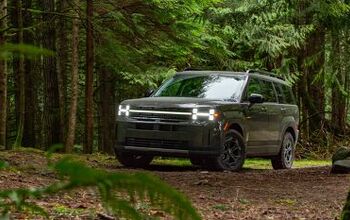2019 Porsche Panamera GTS Review

Usually, a Formula 1 course is full of sporty, lightweight, agile speed machines, but this week, the Bahrain International Circuit is home to the heavy and large but light on its feet 2019 Porsche Panamera GTS.
And while it’s unlikely Panamera buyers would ever take their four-door liftback on the track, the course allows us to experience the sporty performance this GTS model brings to the usually tame Panamera lineup.
Although, calling the Porsche Panamera tame is underselling things a bit, especially when you’re looking at the top-of-the-line Turbo and Turbo S models. These are battleships, capable of blasting off to highway speeds in under 4 seconds and have a price tag to match that kind of exclusive performance.
If you want to save a whopping $20,000 or so, this new GTS model will do the trick. Slotting right between the mainstream Panamera 4S model and the more exclusive Turbo, the GTS is a car that has a capable powertrain, yet more agility-focused features borrowed from the Turbo. The GTS is also available for the first time ever as a Sport Turismo wagon, joining the usual liftback design of the Panamera four-door.
FAST FACTS
| Engine: | 4.0-liter twin-turbo V8 |
| Output: | 453 hp, 457 lb-ft of torque |
| Transmission: | eight-speed dual clutch |
| 0-60 MPH: | 3.9 seconds |
| 0-100 km/h: | 4.1 seconds |
| Top Speed: | 181 mph (292 km/h) |
| Weight: | 4,398 lbs (1,995 kgs) |
| Fuel Economy (MPG): | NA |
| Fuel Economy (l/100kms): | NA |
| Price (USD): | $134,500 |
| Price (CAD): | $153,300 |
The 4.0-liter twin turbo V8 sings a new song, as it has been tuned up to 453 horsepower, which is a modest upgrade from the 440 ponies in the 4S, and a sizable gap from the 550 horsepower in the Turbo. Power isn’t everything, but this is enough to have the Panamera GTS sprint to 60 mph in 3.9 seconds (100 km/h happens in 4.1 seconds) and 120 mph (200 km/h) in just over 15 seconds. The top speed varies between the two body styles, but it can reach at least 180 mph (289 km/h) if you have enough runway. On both the front and back straight of the Bahrain International Circuit, speeds regularly reached that 120 mph mark, not so bad considering multi-million-dollar, purpose-built Formula 1 cars reach the 199 mph mark.
See Also: 2018 Porsche Panamera Review and Video
This Panamera GTS makes all of that happen with a smaller engine than previous iterations, and somehow, more torque too. A flat torque curve starts with peak (457 lb-ft) performance happening as soon as 1,800 rpm and lasts until 4,500 rpm. It’s a rush, and depending on the drive mode, the car can feel like a shook-up bottle of soda, ready to burst. The throttle response is wonderful and speed builds with a limited amount of lag. There are a number of key factors to this response, including the centrally mounted turbos, sometimes called a Hot-V setup. Keeping everything reliable and efficient, there are also catalytic converters mounted in the inner-V of the engine, and there’s a fancy oil-pressure system that ensures the engine and cylinder heads are operating smoothly and keeping cool. We spent many hours in the daylight and spotlights tracking the cars, as the Bahrain International Circuit can run at night time, as it’s blanketed in artificial light when the sun drops. The standard sports exhaust is a nice touch, but the Panamera sounds a touch less manic than the Mercedes-AMGs and M-badged BMWs.
The eight-speed dual-clutch transmission is stunning, which is the norm for Porsche transmissions. It’s always in the right gear, and when another ratio is needed, it swaps it without a chassis disrupting shift-shock. On the intimidatingly complex course, this was a huge advantage, as it handles the gear changing business while drivers manhandle the car around the corners. Fortunately, the Sport Chrono Package is standard equipment, allowing drivers to switch between four drive modes, as well as a sport-response button that dials things up to eleven for 20 seconds, allowing you to make an aggressive pass when needed. Most of the time, these features can feel like gimmicks, but the Sport Response button and its burst of extra speed does have a motorsports-like feel that is actually quite fun to use.
2018 Porsche Panamera Turbo Sport Turismo Review
And manhandling may sound like an abusive term when talking about a track experience, but it’s not easy for a 4,400-lb sedan to elegantly flow through the corners of the track. It requires hard braking, triggering up the ABS and warming up the pricey carbon ceramic stoppers. The Michelin Pilot Sport 4 Tires do their best to hold on and are aided by a number of traction enhancing tools at the cars arsenal. The all-wheel-drive system is particularly robust, featuring a map-based multi-clutch setup. Depending on the driving conditions, power is split between the front and rear wheels to achieve the best grip and traction, and in some cases, more power is sent to the front wheels to pull it through a corner. Other scenarios see power being sent to the rear axle to help rotate the car as needed too.
There is standard adaptive air suspension that raises and lowers the car as needed, but also works in conjunction with the adaptive dampers and controlled via the Porsche 4D Chassis Control system, which computes the task at hand in mere moments and dials in the best combination of suspension, traction control, damping, torque vectoring and the rear wheel steering. Rear wheel steering is all the rage these days with large sedans, and the Panamera GTS is no exception. It’s really noticeable on the track as the rear wheels turn opposite the front wheels at low speeds to achieve a tighter turn, and in parallel with the front wheels to provide more stability at higher speeds. It’s a huge asset on the track, and the car’s rear end feels more lively and exciting. It takes some getting used to, as managing the rear end of such a large and heavy car can be intimidating, but the Panamera’s various control systems take care of all of it for you.
See Also: 2019 Mercedes-AMG GT 4 Door Coupe Review
The steering is the biggest beneficiary of all these systems, allowing the car to feel darty and agile, but lacks a bit in terms of response and engagement. It’s sport-inspired, rather than feeling like the truly engaging steering feel of Porsche’s sports cars. Nonetheless, the Panamera GTS handles like a smaller car when driven hard and fast. One thing that never gets old though is the high-tech spoiler that pops out of the rear bodywork of the standard Panamera. The Sport Turismo Wagon has its own spoiler, but it’s less dramatic than the one on the liftback, which pops up then extends widthwise. It’s a feature that is previously only found on the top of the line Turbo models, and adds extra downforce for handling, and can also work to deter turbulent air if you’re cruising at high speeds with the panoramic roof open.
Moving away from the track, the Panamera performs its greatest trick — it transforms into a very comfortable and smooth luxury sedan. It’s capable of sopping up highway miles with ease, it features a proactive and trustworthy adaptive cruise control and lane keeping assistance system and has nice light steering in normal mode to make parking it very easy. Some of those performance enhancing chassis features are an asset on the road too. The rear wheel steering helps in tight spots, and the air suspension can be raised, providing more ground clearance, which could be helpful in the snow or rain. All of the features that made the Panamera GTS stay lively on the track can help the car feel superb on the road. There’s hardly any other combination of performance, engagement and luxury on the road like this car has.
What makes a GTS model stand out is the extra badass elements that Porsche infuses into it. Blacked out accents like the Sport-design grille, side-skirt and tinted rear tail-lights make the GTS models easy to spot, but the large darker 20-inch wheels are the real kicker. I always fall for the GTS models, partly because the way they look matches the performance so well. It’s worth mentioning that you can get these executive sized sedans in a number of colorful expressions including a bright blue, red, and even green. Our tester featured a unique chalk grey, which is probably the prettiest shade of grey you can get today.
Inside, GTS models feature a heaping tablespoon of Alcantara. The soft material can be found on the steering wheel and if you so like, you can get an extra package to see more of it throughout the cabin. Front seats are 18-way power adjustable, ensuring you’re snug and fit in the car when you decide to put all the handling technology to good use. The rear seats are also accommodating. Six-footers can fit back there without grazing their head, and the legroom isn’t bad either. The real wow-factor is when you pop open the trunk and just how much space is back there.
There is a new center console with more capacitive touch buttons and fewer actual buttons. These always take getting used to and can be hard to trigger while on the infotainment system is bright and easy to use though, and I especially like the new digital gauge cluster found on the latest Porsches. You can switch from the traditional 5 dial layout to something with a large map display if needed. The head-up display is also extremely customizable, which should please the inner gadget-nerd in all of us.
In terms of measured performance, the GTS may not seem like a huge step up from the Panamera 4S, but it has a lot of high-tech features that enhance grip and handling prowess. It bridges the gap perfectly between the Turbo and the more mainstream models and is plenty of fun to drive on the track or off. I fear it may not be on the same tier of straight-line speed as the M5 or Mercedes-AMG E63 S, but the GTS doesn’t need to be. It’s far more agile and engaging than those two. The Porsche faithful may find the pricing to be accommodating. At $128,300 in the U.S. and $146,200 in Canada, it’s $21,700 (U.S.) less than a Turbo, and $19,000 more than a 4S, which both aren’t small gaps. But comes with many of the goodies of the Turbo without the over-the-top powerplant. Sport Turismo wagon models carry a $6,200 price premium in the U.S. or $7,100 in Canada.
The Verdict: 2019 Porsche Panamera GTS Review
At times during our stints on the race track, it’s easy to forget that you’re behind the wheel of such a large car. On the other hand, while you’re out on the road, routine shoulder and mirror checks have you performing a double-take as you remind yourself that you’re in command of something bigger than it feels. It can float like a butterfly, and sting like a bee, but this GTS is definitely the more Porsche-like four-door than the mainstream models.
Discuss this story on our Porsche Forum.
LOVE IT
- Great balance of price and performance
- Cool blacked out exterior
- Fun on the track, stable on the road
LEAVE IT
- Straight-line power and speed lacking compared to AMGs and BMW M cars
- $20k more than a 4S, $20k less than a Turbo

Sami has an unquenchable thirst for car knowledge and has been at AutoGuide for the past six years. He has a degree in journalism and media studies from the University of Guelph-Humber in Toronto and has won multiple journalism awards from the Automotive Journalist Association of Canada. Sami is also on the jury for the World Car Awards.
More by Sami Haj-Assaad




























































Comments
Join the conversation